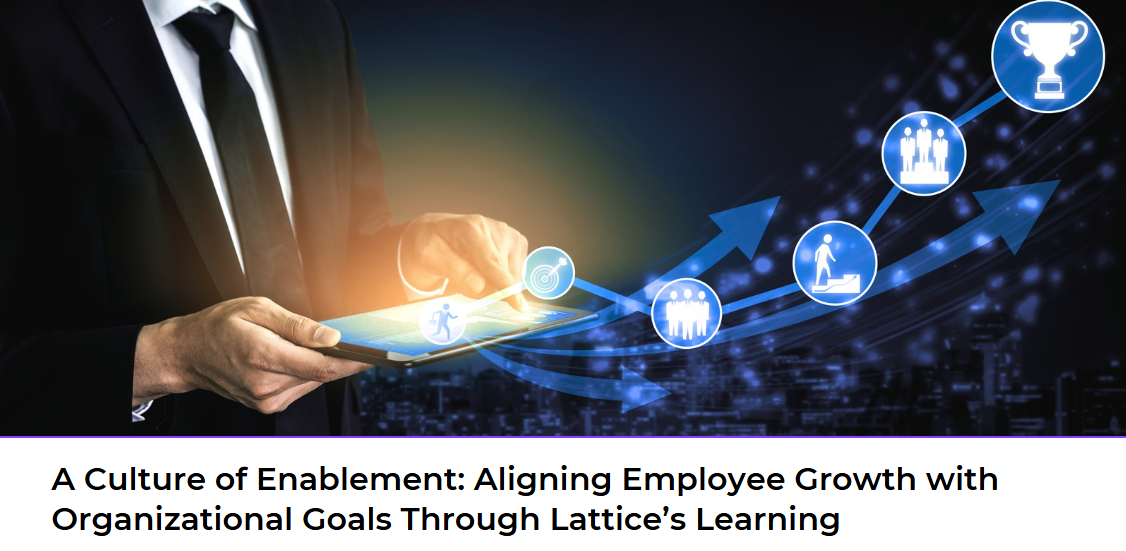A Culture of Enablement: Aligning Employee Growth with Organizational Goals Through Lattice’s Learning Blueprint.

By Sejal Tandon, Practicum Student at PARKER HR Solutions
With editorial contributions by Gifty Parker, Founder & CEO at PARKER HR Solutions.
At PARKER HR Solutions, we closely monitor emerging trends that are reshaping how organizations support employee growth and engagement. We also create opportunities for our practicum and internship students to explore these topics through applied research. One recent case that sparked thoughtful reflection across our team was a webinar hosted by Lattice titled “How Lattice Builds a Culture of Learning from Day One” (Duffy & Banerjee, 2025). It presents a modern vision for employee development—one that blends personal agency with organizational strategy.
Reimagining Growth Beyond Promotions
In today’s dynamic workplace, the concept of professional growth has evolved far beyond the traditional idea of climbing a corporate ladder. The recent webinar hosted by Lattice, titled “How Lattice Builds a Culture of Learning from Day One’’ (Duffy & Banerjee, 2025), showcased how modern organizations can cultivate a meaningful and sustained approach to employee development by empowering individuals and equipping managers to act as developmental partners. Rather than viewing growth solely as a function of promotion, Lattice emphasizes a continuous, multidimensional journey that integrates personal ambition with business needs.
The foundation of Lattice’s approach rests on the belief that employees must take ownership of their development. This is achieved by encouraging individuals to engage in reflective goal-setting through the SEO model—Strengths, Energizers, and Opportunities. This framework invites employees to identify their personal drivers, areas for improvement, and aspirations, thereby providing a structured path forward. Complementing this self-led approach, managers are positioned as supportive collaborators, offering coaching, feedback, and modeling developmental behavior.
To make this vision actionable, Lattice’s Grow platform offers two key tools. First is the Individual Development Plan (IDP), a high-level annual roadmap that aligns personal growth with evolving organizational goals. Second are Growth Areas, which are targeted short-term skill development initiatives that span three to six months and are reviewed quarterly. Together, these tools ensure development planning is both strategic and responsive.
The Three E’s: A Holistic Framework
One of the most powerful takeaways was the “Three E’s of Development”:
Experience (hands-on learning through projects and stretch assignments)
Exposure (learning from others via mentoring, feedback, or shadowing)
Education (formal learning including courses and curated reading
This model offers a comprehensive view of how growth can happen both informally and intentionally.
To support this culture of learning, Lattice has redesigned traditional performance management systems by replacing annual reviews with quarterly check-ins. These check-ins alternate in focus, with the first and third quarters emphasizing performance and the second and fourth centered on development. This rhythm allows for consistent dialogue, reflection, and realignment. Leadership development is also a cornerstone of the model, with programs like the Manager Blueprint and Pathfinder designed to strengthen inclusive leadership, situational coaching, and feedback delivery capabilities among managers.
Clear competency frameworks and career mapping further enrich the process by helping employees understand expectations and pathways for advancement. These frameworks ensure that development efforts are aligned with role-specific requirements and company strategy. Feedback is deeply embedded into the development cycle, as employees regularly receive actionable insights that inform their Growth Areas and track progress over time.
Importantly, the webinar addressed how organizations can support growth during challenging times, such as budget freezes or organizational transitions. The guidance offered was to reframe growth not around promotion, but around skill acquisition and expanded responsibilities. This mindset encourages resilience and continued engagement among high performers, even when advancement opportunities may be temporarily limited.
Measurement plays a critical role in evaluating the effectiveness of this developmental culture. Lattice gathers data from employee engagement surveys, Growth Area tracking, and manager feedback loops to assess whether employees feel they have time, support, and opportunity to grow. These insights are used to refine programs and ensure continuous improvement.
Looking ahead, Lattice is enhancing its offerings through the integration of AI-powered tools. New features include smart growth recommendations tailored to individual profiles, digital development agents that offer guidance throughout the learning journey, and exportable reports that provide visibility and accountability for both employees and managers. These innovations aim to scale development support without losing the personalization that is essential to meaningful growth.
In conclusion, Lattice presents a compelling blueprint for organizations seeking to embed growth into the fabric of their culture. By balancing structure with flexibility, and autonomy with guidance, companies can foster a workplace where development is not an occasional event but an everyday experience. With the right tools, intentional leadership, and an enabling environment, professional growth becomes a shared responsibility—one that benefits individuals and organizations alike.
Reference:
Lattice. (2025, May 13). How Lattice builds a culture of learning from day one [Webinar]. Hosted by Mollie Duffy & Noel Banerjee. https://lattice.com
